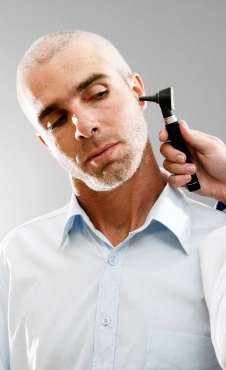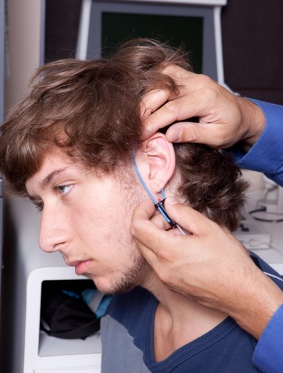Earache is a common medical condition that causes the swelling and inflammation of the structures that makeup the ear. These structures include the tympanic membrane, external auditory canal and the middle ear. Although very common in children, earaches can occur in adults resulting in pain, fever and irritability.
An earache can also be a symptom of an infectious disorder or disease. Although not every ear pain is a reason for concern, it’s best to see a physician as self diagnosing and treatment can be dangerous if there is more harmful underlying condition. An acute ear infection is typically caused by an outer ear infection (external otitis) or middle ear infection (otitis media) while a reoccurring ear ache can be a symptom of a larger problem.

Types of Ear Infections
There are three main types of ear infections that can occur in humans. These are the otitis extern, otitis media and bullous myringitis.
- Otitis Externa: The otitis externa is a type of skin infection that affects the outer ear canal. This type of ear infection is typically the result of swimming, commonly known as ‘swimmers ear’.
- Otitis Media: Otitis media is a type of infection that occurs in the middle ear and the eardrum. This type of ear infection is typically seen in infants and adults but can rarely occur in older children and adults.
- Bullous Myringitis: Bullous myringitis is a type of infection that affects the ear drum. This type of ear infection is typically the result of trauma to the ear or a localized infection.
Symptoms
Each of the three mentioned types of earache conditions come with their own set of common signs and symptoms. Diagnosing the symptoms early on in the infection and visiting a physician for treatment can help to cure the infection before it becomes worse or damaging to ones hearing.
Symptoms of Otitis Externa Include:
- Earache that develops gradually verses overnight onset of pain and discomfort
- Mild itchiness sometimes accompanied by pain
- Worsening of the pain when the upper rim (helix) of the ear is touched or pulled
- Mild or severe loss of hearing
- Buzzing or ringing sound in the ear
- Feeling of stuffiness or block in the ear
- Swelling or inflammation of the inner and/or outer ear
- Thick drainage that comes from the helix and ear canal
Symptoms of Otitis Media Include:
- Irritability, whining, fussing or crying in infants and children
- Partial or complete loss of hearing
- Feeling of blocked or plugged ear
- Buzzing or ringing sound in the ear
- Fever or pain
- Discharge that appears when the eardrum ruptures
- Diarrhea or vomiting
- Lack of appetite or poor feeding in infants
- Unable to sleep or rest
Symptoms of Bullous Myringitis Include:
- Pain in the ear
- Fever
- Partial or full loss of hearing
- Bloody discharge that appears from the ear canal
Causes
Finding the cause of an earache will allow your physician to find the proper diagnosis and treatment fairly quickly. Causes of an earache can differ depending on your age, activity level and environmental factors.
Earache? Get Remedies Fast!
Causes of Otitis Externa Include:
- Trapped moisture or fluid in the ear canal (example: swimmers ear)
- Minor trauma or scrape to the skin covering the ear canal (example: the tip of a cotton swab or small object can break the skin, allowing bacteria to enter)
Causes of Otitis Media Include:
- Bacterial or viral infection caused by a cold or upper respiratory infection which prevents normal fluid drainage from the middle ear
- Allergies
- Exposure to second hand smoke
- Infants can get an ear infection if fed while laying flat
- Family history of earaches or ear infections
- Abnormal anatomy of the neck or head
Causes of Bullous Myringitis Include:
- Trauma to the ear caused by a blow or inserted object
- Localized infection
- Pressure due to flying in an airplane or diving
- Exposure to a load sound or noise
Risk Factors

Eliminating or maintaining risk factors that can lead to an earache can help reduce the number of infections that occur. Age plays a major role in ear infections with over two-thirds of children experiencing an earache before they turn three. Boys are also more likely to experience earaches than girls. This is because infants and small children have ear structures that are still growing. As they age, their ears will enlarge and their immune systems will strengthen, fighting off these common childhood infections.
Risk Factors of an Earache Include:
- Allergies can cause inflammation in the ears that block airways
- Children exposed to other children (such as in a daycare) as respiratory infections can spread easily
- Exposure to second hand smoke can lead to acute earaches
- Bottle fed infants have a higher risk of acquiring an ear infection
- The use of pacifiers as a risk due to the production of saliva that leads to the spread of bacteria
- Obesity has been found in connection to otitis media
Prevention Tips
The prevention of earaches and ear infections can help to reduce the number that occurs each year, especially to infants and young children. Follow these simple prevention method to help stop earaches.
Prevention Tips for Otitis Externa Include:
- Gently dry the ears after swimming or when the ears come in contact with water
- Shake the head to remove any excess water
- Hold a hair dryer on low to dry out the inside ear canal (the hair dryer should be held at least 12 inches away from the ear)
- Wear earplugs while swimming
- Avoid putting your ears beneath the water line while in a bath tub
- Do not insert any objects into the ear besides q-tips (example: paper clip, fingernails, bobby pins, etc.)
- Avoid cleaning the ears frequently as they are mostly self-cleaning
- Removal of wax-buildup in the ears should be done by a professional under an otoscope
- Allow a health professional to remove any insects or other foreign objects that may have become stuck inside the ear
Prevention Tips for Otitis Media Include:
- Avoid children’s exposure to other children and adults with colds or upper respiratory infections
- Do not bottle feed an infant in a lying or flat position
- Consider breast feeding verses bottle feeding for a reduced risk of ear infections
- Do not allow a child to use a pacifier after six months of age
- Avoid exposure to secondhand smoke
- Keep children’s immunizations updated, especially for influenza
Prevention Tips for Bullous Myringitis Include:
- Avoid standing in front of speakers or other noises that give out loud sounds
- Be cautious while playing physical contact sports or activities to avoid a blow to the ear
- Wear earplugs or chew gum while flying in an airplane to help reduce the risk of your ears “popping”
Test and Diagnosis Considerations
If you think you may have an earache or ear infection, it’s essential that you visit a physician before the condition worsens. Diagnosis of an earache consists of taking a patient’s medical history, an examination of the ear and surrounding areas and various laboratory and hearing tests may be performed.
Use of Otoscope for Diagnosis of an Earache:
Otitis Externa: An otoscope can be used to diagnosis otitis externa as the ear canal will appear inflamed and swollen. Thick discharge may be present and the insertion of the scope into the canal will cause pain to the patient.
Otitis Media: An otoscope can be used to diagnosis otitis media as the physician examines the ear drum. Fluid bubbles and air may be present inside the ear drum and it may look red and inflamed.
Bullous Myringitis: An otoscope can be used to diagnosis bullous myringitis by inserting the scope to examine the ear drum. Small blisters filled with fluid may be present.
Hearing Tests for Diagnosis of an Earache
Hearing tests may be recommended for patients who have had reoccurring earaches or ear infections. They may also be used for children with a speech delay as this can be connected to an earache. During a typical hearing test, the patient may wear a pair of headphones and listen to various tone depths. If they are unable to hear some or all of the tones, they may have an ear infection.
Laboratory Tests for Diagnosis of an Earache
Drainage samples from the infected area are sometimes sent to the hospital laboratory to check for signs of bacteria. Laboratory tests are not typical for ear infection patients and are reserved for those individuals who do not respond to other treatments.
Treatment Options
The treatment of earaches commonly requires the use of antibiotics of self care remedies. Occasionally, a patient may need a surgical procedure performed to completely cure the damage done by an ear infection or ear trauma.
Home Self-Care for Earaches
Although ear infections should be diagnosed and treated by a physician, the uncomfortable symptoms caused by the infection can be treated at home. The use of over the counter pain relievers such as ibuprofen or acetaminophen can be used to reduce pain accompanied by the earache. A warm compress can also be placed against the infected area to help with pain control.
Medical Treatment for Otitis Externa
The majority of cases of otitis externa are cured with the use of prescribed eardrops for a period of seven to ten days. These eardrops contain a steroid and antibiotic to fight off infection and reduce inflammation and swelling in the ear. The drops are placed in the ear while the individual in lying on their side. The patient should remain on their side for a minimum of five minutes to allow the drops to enter the ear canal. An oral antibiotic may also be prescribed to keep the infection under control through treatment. During the treatment, the ear canal should be kept completely dry. Ear plugs should be worn for bathing, showering and swimming during this time.
Medical Treatment for Otitis Media
There are several treatments available for otitis media. Oral antibiotics are typically given to adults who acquire the condition for quick treatment. Observation is usually the only treatment needed for infants and children as most cases of otitis media in children will treat itself over a period of one to two weeks. For more severe cases of otitis media in children, follow up care may be needed resulting in antibiotics to cure the ear infection. Over the counter pain medications may be recommended to reduce the pain accompanied by the earache. A humidifier may also be used to moisten the air.
Medical Treatment for Bullous Myringitis
Treatment for bullous myringtis may include ear drops, oral antibiotics and symptom related pain medications. Bullous myringtis earaches usually resolve themselves in one to two days of treatment. It’s important not to stop the treatment before all the antibiotics are taken as the infection may still be present even if the symptoms are gone. A follow up may be recommended as well as a hearing test if symptoms do not subside. Your physician may refer more severe cases to an ear, nose and throat specialist for future examination.

2 Comments
Great article. I find that many children fight chronic ear aches and ear infections due to an imbalance in their nerve system. I have helped many kids recover very efficiently with chiropractic care. I find that the upper cervical region has an intimate relation with the inner workings of the ear. Parents can’t believe it when their child recovers so fast. If you are suffering from ear aches or ear infections you should consider a consultation with a local chiropractor.
What if the toddler is still on a pacifier and the mother has taken the toddler to the doctor a numerous of times and put her on medication and it is not helping.